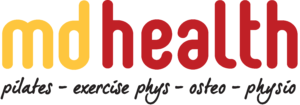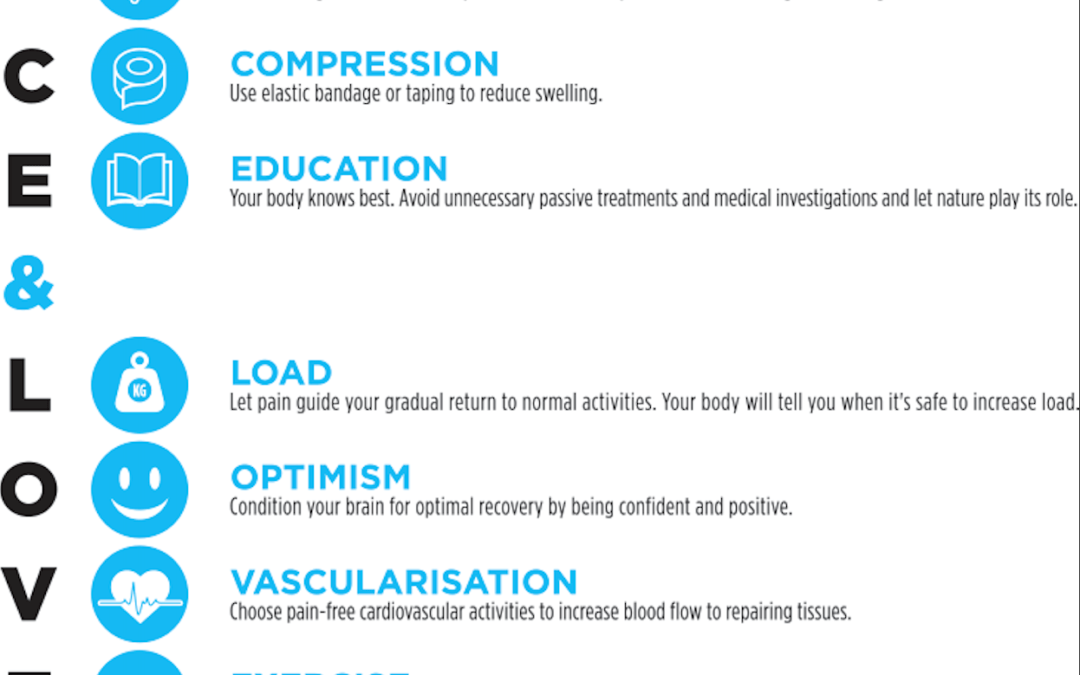Traditionally, the recommended management for soft tissue injuries has been the RICER, RICE or PRICE methods. These models however only accommodate for the acute management of these injuries (0-72 hours after injury, depending on severity). A new model of soft tissue management has been proposed recently, suggesting that these injuries need PEACE and LOVE.
These acronyms are elaborated on below, and in the graphic:
P – Protect the injured area by unloading the area for 1-3 days post-injury. Unloading should be kept to a minimum based on severity, so as to reduce loss of tissue strength and quality.
E – Elevate the affected limb to promote interstitial fluid flow out of the area.
A – Avoid anti-inflammatory modalities (neurofen, voltaren, both gel and oral applications) as these can be detrimental to tissue healing.
C – Compression to affected area, via bandaging or compression bandage – helps to limit joint swelling and reduce loss of range of movement.
E – Education provided by health professional, a crucial part of injury management! An active approach to recovery should be encouraged, including strength-based rehabilitation exercises. Passive modalities (soft tissue massage, acupuncture/dry needling, and electrotherapy) should be avoided if possible, as there is limited evidence to support these in rehabilitation. Realistic goals and time frames for recovery should be set, and patient workloads managed accordingly.
AND after initial management of injury:
L – Load the area, gradually and as tolerable. An active approach to therapy via exercise is beneficial to most musculoskeletal injuries. This promotes tissue healing, tissue remodelling and helps improve the tissue tolerance to further loading in future.
O – Optimism! A positive outlook towards rehabilitation has a massive impact patient prognosis. Focusing on pain, catastrophising (thoughts that it will never recover), depression and fear can lead to poorer OR longer recoveries.
V – Vascularisation – get the limbs moving to promote blood flow in and out of the area. Some early cardiovascular exercises (walking, running, cycling, swimming are good examples) can help improve tissue recovery and pain, and also serves to help improve patient motivation.
E – EXERCISE!!! There is strong levels of evidence for exercise as therapy in musculoskeletal injuries, to help restore mobility, strength and proprioception of the affected area.
Injury management is more than just short term damage control! Clinicians working with injured individuals should all aim to treat the person with the injury, and not just the injury of the person.
Article source: Blaise DuBois and Jean-Francois Esculier, & British Journal of Sports Medicine.
https://blogs.bmj.com/bjsm/2019/04/26/soft-tissue-injuries-simply-need-peace-love/
Do you have any questions?
- Call us on (03) 9857 0644 or (07) 3505 1494 (Paddington)
- Email us at admin@mdhealth.com.au
- Check out our other blog posts here
Our clinical staff would be happy to have chat if you have any questions.
Take the first step to a healthier you!
Would you prefer for someone to contact you regarding booking your Initial Physiotherapy appointment, Initial Exercise Physiology, Initial Osteopathy session or FREE Full Body Assessment*?
Or do you have any other enquiry about our services at MD Health?
Please fill in this form and someone from MD Health will be in touch with you soon.
Alternatively please call us on 03 9857 0644 (Kew East), 03 9842 6696 (Templestowe), 03 8683 9442 (Carlton North) or 07 3505 1494 (Paddington) to book now!
*Please note only the Full Body Assessment is a FREE service. The Full Body Assessment is for new clients at MD Health or returning clients who haven’t been in for 6 months or longer who intend to particpiate in our 13 Week Clinical Pilates Program**.
For all new clients who wish to come in for a one-off, casual or adhoc basis for Physiotherapy or Exercise Physiology the Initial Physiotherapy or Initial Exercise Physiology appointment is a paid service.
** The 13 Week Clinical Pilates Program at MD Health is not a lock in contract and you are not required to attend for the full 13 weeks if you do not wish.
This site is protected by reCAPTCHA and the Google Privacy Policy and Terms of Service apply.



